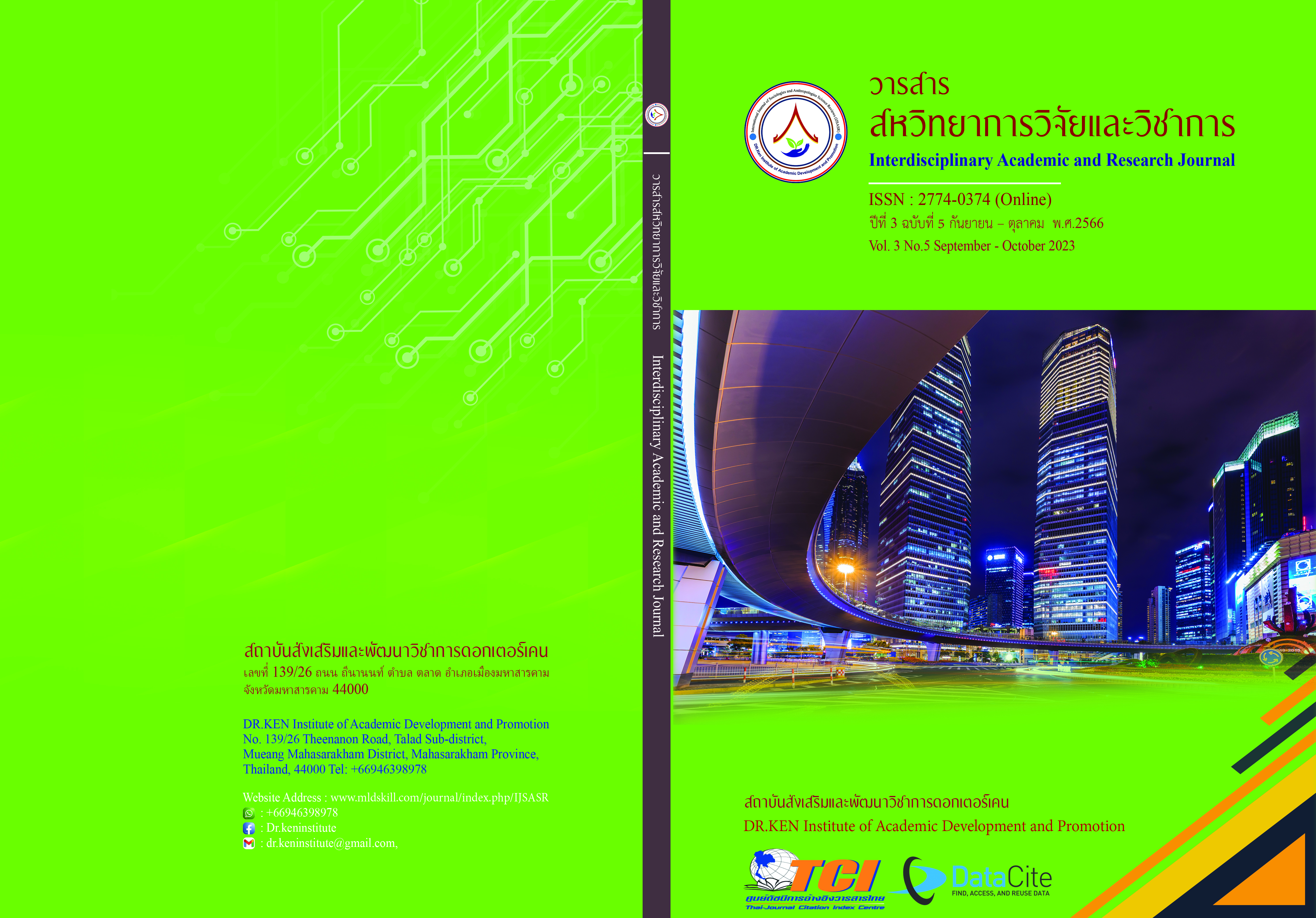The Effect of Learning Management Based on Constructivist Theory Using Hand-on Activities of Grade 6 Students’ Geometrical Concepts on Triangle
DOI:
https://doi.org/10.14456/iarj.2023.263Keywords:
Constructivist; , Hand – on activities; , Geometrical conceptsAbstract
Mathematical concept is one of the important things to learn mathematics in the 21st century. The mathematical concept is a concept about mathematics content, complete knowledge, and understanding that will lead to thinking, learning, and used to solve problems effectively. Geometry is a fundamental element of mathematics but effect of organizing mathematics learning, it was found that the students' geometrical concepts were lower than the specified criteria. Therefore, the purpose of this research was to study the grade 6 students’ geometrical concepts of triangles after they had learned through learning management based on a constructivist theory using hands–on activities. The sample was 22 Grade 6 students in one classroom in the second semester of the academic year 2022 that was selected by cluster random sampling from 2 classrooms, the classroom was heterogeneous. The research instruments used in this research were six mathematics lesson plans on triangles and 20 20-item tests with four multiple-choice choices on the geometrical concept of triangles. Percentage, mean, standard deviation, and t-test were used to analyze data and were presented by tables and descriptions. The research found that geometrical concepts of grade 6 students on triangles after learning management based on a constructivist theory using hands–on activities were higher than 60% of the criterion at the .05 level of significance.
References
โกมล ไพศาล. (2540). การพัฒนาชุดการสอนเรขาคณิตสำหรับครูคณิตศาสตร์ระดับมัธยมศึกษาตอนต้น. ปริญญานิพนธ์การศึกษาดุษฎีบัณฑิต สาขาคณิตศาสตร์ศึกษา : มหาวิทยาลัยศรีนครินทรวิโรฒ.
ทิศนา แขมมณี. (2555). ศาสตร์การสอน: องค์ความรู้เพื่อการจัดกระบวนการเรียนรู้ที่มีประสิทธิภาพ.พิมพ์ครั้งที่ 16. กรุงเทพฯ : ด่านสุทธาการพิมพ์.
นวลศรี ชำนาญกิจ. (2544). การพัฒนาตัวแบบเพื่อสร้างสมรรถภาพการสอนภาพลักษณ์มโนทัศน์ทางเรขาคณิตสำหรับนักศึกษาครู. ปริญญานิพนธ์การศึกษาดุษฎีบัณฑิต สาขาคณิตศาสตร์ศึกษา : มหาวิทยาลัยศรีนครินทรวิโรฒ.
ปานทอง กุลนาถศิริ. (2541). การสอนเรขาคณิต ในระดับประถมศึกษาในศตวรรษที่ 2. วารสารสสวท. 26 (102), 3-5.
มาโนช บุญคุ้ม. (2554). การพัฒนาความคิดรวบยอดเรื่อง รูปสี่เหลี่ยม และการให้เหตุผลทางคณิตศาสตร์ของนักเรียนชั้นประถมศึกษาปีที่ 6 โดยใช้กิจกรรมปฏิบัติ โรงเรียนชุมชนบ้านร้องเข็ม อำเภอร้องกวาง จังหวัดแพร่. ปริญญาศึกษาศาสตรมหาบัณฑิต สาขาคณิตศาสตร์ศึกษา : มหาวิทยาลัยเชียงใหม่.
วีณา ประชากูล และ ประสาท เนืองเฉลิม. (2563). รูปแบบการเรียนการสอน. พิมพ์ครั้งที่ 4. ขอนแก่น : คลังนานาวิทยา.
เวชฤทธิ์ อังกนะภัทรขจร. (2555). ครบเครื่องเรื่องควรรู้สำหรับครูคณิตศาสตร์: หลักสูตร การสอนและการวิจัย. กรุงเทพฯ : จรัสสนิทวงศ์การพิมพ์.
สถาบันส่งเสริมการสอนวิทยาศาสตร์และเทคโนโลยี (สสวท). (2551). ทักษะ/กระบวนการทางคณิตศาสตร์. กรุงเทพฯ : ส เจริญการพิมพ์.
สมทรง สุวพานิช. (2553). เรขาคณิต.ศาสตร์มหัศจรรย์. วารสารครุศาสตร์ มหาวิทยาลัยราชภัฎมหาสารคาม. 7 (1), 33-37.
สมวงษ์ แปลงประสพโชค. (2554). การจัดประสบการณ์การเรียนรู้คณิตศาสตร์แบบปฏิบัติการและแบบอิงโครงงาน. ประมวลสาระชุดวิชาการจัดประสบการณ์การเรียนรู้คณิตศาสตร์. นนทบุรี : มหาวิทยาลัยสุโขทัยธรรมาธิราช: 1-56.
สมศรี คงวงศ์. (2542). การพัฒนากิจกรรมการสอนการแก้โจทย์ปัญหาคณิตศาสตร์ชั้นประถมศึกษาปีที่ 6 ตามแนวคิดของทฤษฏีคอนสตรัคติวิสต์ และการสอนแบบร่วมมือกันเรียนรู้. ปริญญาศึกษาศาสตรมหาบัณฑิต สาขาวิชาการประถมศึกษา : มหาวิทยาลัยขอนแก่น.
สำนักงานคณะกรรมการการศึกษาแห่งชาติ. (2540). ทฤษฎีการเรียนรู้เพื่อพัฒนากระบวนการคิด. กรุงเทพฯ : ไอเดีย สแควร์.
สำนักงานเลขาธิการสภาการศึกษา. (2550). การจัดการเรียนรู้แบบประสบการณ์และที่เน้นการปฏิบัติ. กรุงเทพฯ : กระทรวงศึกษาธิการ.
สิริวรรณ ตั้งจิตวัฒนะกุล. (2561). รากฐานเรขาคณิต. พิมพ์ครั้งที่ 9. กรุงเทพฯ : มหาวิทยาลัยรามคำแหง.
สุรางค์ โค้วตระกูล. (2554). จิตวิทยาการศึกษา. พิมพ์ครั้งที่ 6. กรุงเทพฯ : โรงพิมพ์แห่งจุฬาลงกรณ์มหาวิทยาลัย.
อัมพร ม้าคนอง. (2546). คณิตศาสตร์: การสอนและการเรียนรู้. กรุงเทพฯ : โรงพิมพ์แห่งจุฬาลงกรณ์มหาวิทยาลัย.
อัมพร ม้าคนอง. (2558). คณิตศาสตร์สำหรับครูมัธยม. พิมพ์ครั้งที่ 2. กรุงเทพฯ : โรงพิมพ์แห่งจุฬาลงกรณ์มหาวิทยาลัย.
อุดม ต่วนเทศ. (2547). ผลการสอนคณิตศาสตร์แบบให้ผู้เรียนเป็นผู้สร้างองค์ความรู้โดยใช้มูฟที่มีต่อภาพลักษณ์มโนทัศน์ทางเรขาคณิต และผลสัมฤทธิ์ทางการเรียนเรขาคณิต ของนักเรียนชั้นมัธยมศึกษาปีที่ 2. วิทยานิพนธ์ครุศาสตรมหาบัณฑิต สาขาหลักสูตรและการสอน : มหาวิทยาลัยราชภัฏนครสวรรค์.
Gagné, E. D. (1985). The cognitive psychology of school learning. Boston, MA: Little, Brown and Company.
Kathleen, H. (2005). Hand-on math: Lea Hands-on math: Learning Addition and subtraction Through Manipulative Activities. Trafford Publishing.
Santoro, A. M. (2004). The Academic Value of Hands-on Craft Project in School. New York.
Vinner, S. (1983). “Concept Definition, Concept Image, and the Notion Function”. Journal for Research in Mathematics Education. 20 (4), 356-366.
Downloads
Published
How to Cite
Issue
Section
License
Copyright (c) 2023 Natnicha Bunyodom, Songchai Ugsonkid, Wandee Kasemsukpipat

This work is licensed under a Creative Commons Attribution-NonCommercial-NoDerivatives 4.0 International License.
Copyright on any article in the Interdisciplinary Academic and Research Journal is retained by the author(s) under the under the Creative Commons Attribution-NonCommercial-NoDerivatives 4.0 International License. Permission to use text, content, images, etc. of publication. Any user to read, download, copy, distribute, print, search, or link to the full texts of articles, crawl them for indexing, pass them as data to software, or use them for any other lawful purpose. But do not use it for commercial use or with the intent to benefit any business.
















.png)


